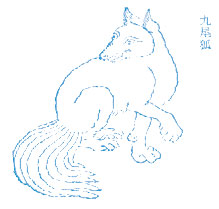This is only the beginning part of the painting, which depicts the early stage of the banquet.
Please bear the concept of time in mind, which is a key element to the form of this painting.
I just have stolen this painting from the treasure vault. It was probably the most guarded place I have ever been into, as a conservator, I have absolutely 100 percents of chance to enter the Palace Museum. But since I am now officially a perpetrator. I might be secretly executed by the government if I got caught.
This painting comprises the huge secret, as the Chinese will put "a secret surprised the heaven and shaking the earth". It has occult power inside as many people believed when the author Gu Hongzhong initially created this painting commissioned by Southern Tang emperor Li Yu. It was said that Han Xizai's house had a humanimal spirit lived in, known as Huli Jing, a fox which can transfigure into a woman and seduces man, so that she can extract his Chi to be more powerful.

A Huli Jing often has 9 tails, which indicates they have nine lives.
According to the legend, when Gu sneaked into Han's house, he not only witnessed the lavish revel happened inside the garden, but also the secret transformation of Huli Jing. As he witnessed the transformation and was enchanted by the Huli Jing. That is the reason why he was so inspired by the scene at Han's and made the this masterpiece with unnatural help from the Huli Jing. As the painting shares so many links with the Huli Jing, someone even claimed that the painting was actually never painted by Gu, instead, the Huli Jing used her magic to create this painting and forged Gu's signature, as Gu was deeply fascinated by her. Later, when the emperor knew about the involvement of Hu lijing, he immediately executed Han's family and ordered to find out the whereabout of the Huli Jing.
However, the attempt of catching Huli Jing was clearly futile in the beginning, I mean how can a mortal put up to fight a supernatural creature? Also, the debate around whether a Huli Jing is a human or not is still going on. When she transformed into a lady, the figure is just way too tangible to refuse her as a human. So, a Huli Jing is a humanimal.
As for myself, I believe that the spirit of Huli Jing has somehow integrated into this painting, and probably hidden in one of the figures, as one of the waitresses. Or maybe the Huli Jing is already very powerful that she actually sucked up all Han's Chi, and transfigured into him. But that would be a victory for the spirits and monsters, they can finally achieved some kind of success in pretending in human's society. I know what you are thinking. Yes, ancient Chinese legends are very anthropocentric and sometimes can be corrupted. Bur the point is that Huli Jing might still hidden inside that painting for more than a thousand of years.
Since I am conservator in the Palace Museum, I have almost full access to most of the paintings. I lied to my director that a small part of the painting has been discolored and I have do a thorough exam and fix it fast.
That is the story how I smuggled the painting out. In order to suppress the evil spirit inside the painting

This is only the beginning part of the painting, which depicts the early stage of the banquet.
Please bear the concept of time in mind, which is a key element to the form of this painting.
These five sections were presented in the same time and space by scrolling through the painting, which left an anachronistic impression for the viewers.

